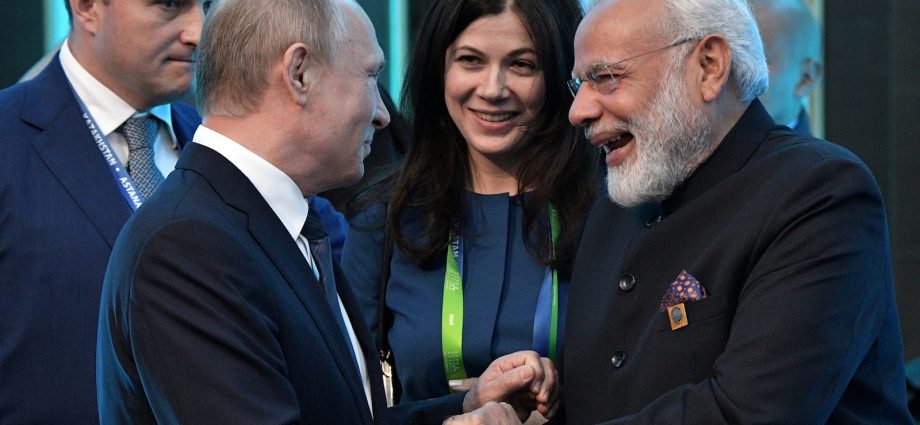In the past decade, global geopolitical transitions have gathered momentum. This is largely due to the emergence of the Indo-Pacific as the global center of gravity. Obituaries of the US-led liberal international order may be exaggerated, but the shift towards multipolarity is in motion.
The primary reason for this has been the continued rise of a belligerent China and the consequent strategic complications. They include the growing US-China hegemonic tussle and the geopolitical compulsions of other powers.
Russia’s war in Ukraine has hastened the transition. US treaty allies in the Indo-Pacific have castigated Russia, but China and India have remained non-committal.
Russia and China proclaimed the emergence of a “new multipolar order” in a February 2022 joint statement at the Brazil, Russia, India, China and South Africa (BRICS) and Shanghai Cooperation Organization (SCO) summits.
Major and middle powers are also considering their own distinct outlooks in a multipolar world. In 2022, German Chancellor Olaf Scholz noted that Russian President Vladimir Putin’s invasion of Ukraine marks a turning point in global politics.
Among all the powers, India seems the most committed to a multipolar world, and has portrayed itself as a strong leader of the developing world. More importantly, India strives to shape a multipolar world that rejects great power politics and reflects today’s diversity and hinges on inclusive cooperation.
The evolution of Indian foreign policy is often seen through the prism of non-alignment to multi-alignment to pointed alignment, based on realpolitik. This is evidenced by India’s recent handling of the Russia–Ukraine war and the West versus Russia conundrum. New Delhi has adroitly projected itself as a neutral centerpiece within the China—West divide.
India’s so-far successful hedging between Russia and the United States is reminiscent of the US-China dilemma faced by most Asian states. But silent and invisible Russia–China competition presents a distinct challenge to India — Russia is India’s historical partner while China has been a constant adversary.
China’s contentious rise has propelled India’s inclusion into US-led Indo-Pacific institutional architecture. This takes shape primarily through forums such as the Quadrilateral Security Dialogue (Quad), Quad Plus and Indo-Pacific Economic Framework for Prosperity.

Fears and antagonism consolidated in 2022. China’s ‘no limits’ partnership between Moscow and Beijing — as opposed to India’s ‘principled’ Russian stance based on pure national interests — is one. Border clashes have also accelerated mistrust.
China is India’s foremost security challenge and is gradually being recognised as a permanent threat. China–India rivalry is not limited to land border disputes. It also encompasses geopolitical issues within the maritime domain.
India is pursuing across-the-spectrum bilateral engagements with states that have significant stakes in Indo-Pacific stability, and is also working with trilateral, minilateral and multilateral forums.
Preserving strategic autonomy is an essential objective for New Delhi. Foreign Secretary Harsh Shringla has interpreted strategic autonomy as self-reliant thinking drawn from Indian philosophical practices and adopted this ‘Indian nature of strategic thinking’ as the first pillar of Indian diplomacy.
India’s multipolar focus is its second pillar of diplomacy. India envisages itself as a major pole in global politics, after the United States, Russia and China. For a long time, India has been dubbed a state with enormous potential — but has remained a middle power, unable to tap into this promise.
Still, India will be able to move beyond the middle power construct and close this gap with major powers. India has been gaining confidence by unapologetically forging relations to maximize its position without alienating partners and rivals alike.
Asian unity has always been central to India’s future worldview. India is working towards bringing Indo-Pacific middle powers together to achieve common developmental goals.
India rejects China’s version of a multipolar world that stresses antagonism with the West and propagates an imperialistic “China dream.”
But a bipolar world will not serve Indian interests either. India seeks to keep both the United States and China in check through a global redistribution of power. This entails reform within international institutions, a goal that it has been advocating for many years.
But China is hindering Asian and global representation. Maintaining the status quo in the UN grants China disproportionate representation as the lone Asian representative.
China’s implicit opposition to India’s bid for a permanent UN Security Council seat can therefore be seen through this lens. Until India achieves power parity with China through permanent participation in international bodies, it cannot fully capitalize on its global power projection.
India can resist China’s control over Asian governance through outreach to the developing world within China-dominated forums, such as the expanding SCO and BRICS+. This helps India deter China from coalescing a section of the non-Western world to further its own multipolarity with “Chinese characteristics.”

Criticism of a multipolar world as transactional politics, which provides only questionable stability, is valid. But some have surmised that deft governance could ensure better, less fragile stability.
The revitalized Quad is one such example. The Quad is also a harbinger of effective multipolarity. If India’s grand projections for its hosting the G20 and SCO summits in 2023 are anything to go by, the concrete benefits of multipolarity will become apparent in the near future.
As things stand, the world could enter an era of asymmetrical multipolarity, where stronger poles still dominate, but major and middle powers cooperate and coexist.
Jagannath Panda is the Head of the Stockholm Center for South Asian and Indo-Pacific Affairs at the Institute for Security and Development Policy, Sweden, and a Senior Fellow at the Hague Centre for Strategic Studies, the Netherlands.
This article, republished with permission, was first published by East Asia Forum, which is based out of the Crawford School of Public Policy within the College of Asia and the Pacific at the Australian National University.
It also appears in the most recent edition of East Asia Forum Quarterly, ‘China Now’, Vol 15, No 1.

